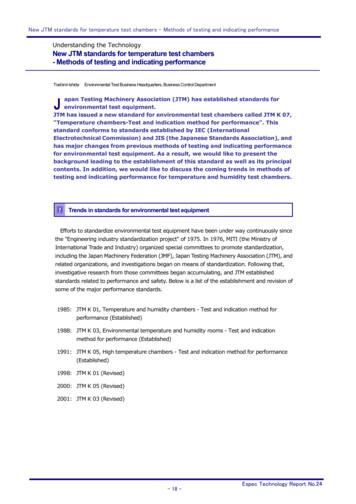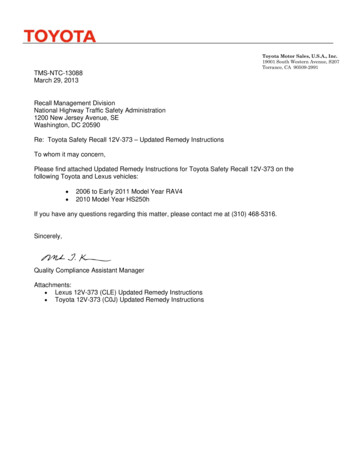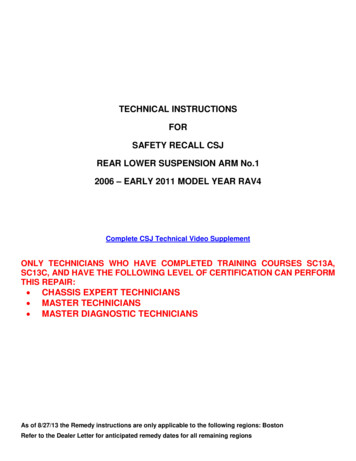
Transcription
New JTM standards for temperature test chambers - Methods of testing and indicating performanceUnderstanding the TechnologyNew JTM standards for temperature test chambers- Methods of testing and indicating performanceToshimi IshidaEnvironmental Test Business Headquarters, Business Control DepartmentJapan Testing Machinery Association (JTM) has established standards forenvironmental test equipment.JTM has issued a new standard for environmental test chambers called JTM K 07,"Temperature chambers-Test and indication method for performance". Thisstandard conforms to standards established by IEC (InternationalElectrotechnical Commission) and JIS (the Japanese Standards Association), andhas major changes from previous methods of testing and indicating performancefor environmental test equipment. As a result, we would like to present thebackground leading to the establishment of this standard as well as its principalcontents. In addition, we would like to discuss the coming trends in methods oftesting and indicating performance for temperature and humidity test chambers.1Trends in standards for environmental test equipmentEfforts to standardize environmental test equipment have been under way continuously sincethe "Engineering industry standardization project" of 1975. In 1976, MITI (the Ministry ofInternational Trade and Industry) organized special committees to promote standardization,including the Japan Machinery Federation (JMF), Japan Testing Machinery Association (JTM), andrelated organizations, and investigations began on means of standardization. Following that,investigative research from those committees began accumulating, and JTM establishedstandards related to performance and safety. Below is a list of the establishment and revision ofsome of the major performance standards.1985: JTM K 01, Temperature and humidity chambers - Test and indication method forperformance (Established)1988: JTM K 03, Environmental temperature and humidity rooms - Test and indicationmethod for performance (Established)1991: JTM K 05, High temperature chambers - Test and indication method for performance(Established)1998: JTM K 01 (Revised)2000: JTM K 05 (Revised)2001: JTM K 03 (Revised)- 18 -Espec Technology Report No.24
New JTM standards for temperature test chambers - Methods of testing and indicating performanceThe driving force for promoting environmental testing software has included the United Statesmilitary standards (MIL) and the IEC and JIS standardization of electrical, automotive, andmaritime standards. JTM has been at the forefront for promoting the standardization ofhardware. These industrial standards have been established for the purpose of contributing to theimprovement and maintenance of product quality and to international standardization.The IEC standards and JIS standards for environmental test equipment have been establishedas follows.2001: IEC 60068-3-5, Environmental testing - Part 3-5: Supporting documentation andguidance - Confirmation of the performance of temperature chambers2006: JIS C 60068-3-5, Environmental testing - Part 3-5: Supporting documentation andguidance - Confirmation of the performance of temperature chambersThe contents of this JIS standard matches the contents of the above IEC standard. The IEC andJIS standards for temperature test chambers are utilized for all equipment used in environmentaltesting and are provided for the general use of the user to confirm the performance of testchambers. Since these standards constitute guidance, there is a danger that when put intopractice they may be subject to a number of interpretations. Because of that, JTM has taken aproper understanding of the contents of these standards, and including portions that are unclearor not stipulated in the standards as well as contents that made up the previous JTM standardshas developed new JTM standards.The new JTM standards target the “temperature test chambers” and have changed thecontents of JTM K 01 (Temperature and humidity chambers - Test and indication method forperformance), JTM K 03 (Environmental temperature and humidity rooms - Test and indicationmethod for performance), and JTM K 05 (High temperature chambers - Test and indicationmethod for performance) to create the new JTM standards. However, the new standards will bephased in over the course of 5 years following their publication.In addition, JTM is planning to publish new standards targeting “temperature and humidity testchambers” as well.- 19 -Espec Technology Report No.24
New JTM standards for temperature test chambers - Methods of testing and indicating performance2New test and indication methods for performanceTable 1 presents an overview of the major revisions to the standards.Table 1 Principal changes in the new JTM standardsCurrent standardsCommentsRange of temp. fluctuationTemp. fluctuationMethod of confirmingperformance alsochangedTemp. uniformityTemp. gradient, Temp.variation in spaceMethod of confirmingperformance alsochangedHeating/cooling timeTemp. rate of changeMethod of confirmingperformance alsochangedDistance ofworkingspaceSpace excluding 1/6 ofdistance from inner wallsSpace excluding 1/10 ofdistance from inner wallsMinimum valuesspecified for differenttest chamber volumesRange of temp.fluctuationMeasurement point: singlepoint at center of chamberCalculation method: take thedifference between averagehigh and average low temps,divide by two, and express as valueTemp.uniformityConcept: Difference betweencenter of chamber and 8 cornerpointsMeasurement points: 9 points(chamber center and 8corners)Calculation method: take thehighest value of the standarddeviation among all of themeasurement points, double it,and express as value.Concept: Difference betweencenter of chamber and 8 cornerpoints, and difference amongcornersHeating/coolingtimeDefinition: Time required toreach max/min temp. fromambient temp.Expression: n1 to n2 ,x minutesMethod of indicatingperformanceMethod of confirming performanceNew standardsDefinition: Rate of temp.change during one minute forspecified timesExpression:K/minute or /minuteTime to reach temp.extreme conforms topriorheating/coolingtimeLet’s consider the major points of the new standards.- 20 -Espec Technology Report No.24
New JTM standards for temperature test chambers - Methods of testing and indicating performance2-1 Working spaceThe working space is a test chamber area that can maintain specified temperature conditionswithin an allowable range. The test chamber generally takes the shape of a rectangular box, andthe working space is composed of the area surrounded by the shaded surface shown in Fig.1. Thedistance from each of the wall surfaces surrounding the working space to the next correspondingchamber surface shall be termed as L1, L2, and L3, respectively. Current standards define theworking space as the space between the surrounding walls excluding the area adjacent to thewalls composed of a distance divided by 6 from the total surface distance, expressed as L1/6,L2/6, and L3/6. The new standards define the working space as the space between thesurrounding walls excluding the area adjacent to the walls composed of a distance divided by 10from the total surface distance, expressed as L1/10, L2/10, and L3/10. However, since it isnecessary to consider the effect of thermal emissions in the space between the inner walls of thetest chamber and the test specimens, the distance from the inner walls must be specified as aminimum value according to the volume of each test chamber.Fig.1 Working space- 21 -Espec Technology Report No.24
New JTM standards for temperature test chambers - Methods of testing and indicating performance2-2 Range of temperature fluctuationThe range of temperature fluctuation in the current standards is defined as the differencebetween the average high temperature and the average low temperature at the center of the testchamber. The new standards refer to temperature fluctuation, which is defined as thedifference between the maximum and minimum temperatures at discretionary points in theworking space measured at specified time intervals after the temperature has stabilized. The newstandards have set the discretionary points as being at the center and at the corners of theworking space. As can be seen in Fig.2, to find the range of fluctuation according to currentstandards, average temperatures are first calculated for a measured point in the center of thechamber. Then, the average temperatures are separated into high and low temperatures and theaverage high and low temperatures are calculated, and the fluctuation is defined as the differencebetween these high and low averages. This difference is divided by two, and then that result isdisplayed as a value.Fig.2 Temperature fluctuation in current standardsThe calculation method used by the current standards is as follows.Average temp. Average high temp. Average low temp. Range of temperature fluctuation (average high temp. - average low temp.)/2- 22 -Espec Technology Report No.24
New JTM standards for temperature test chambers - Methods of testing and indicating performanceNo specific measurement procedures are presented in JIS C 60068-3-5 (IEC 60068-3-5).Actual measurements are performed at user-selected sampling intervals, and so one cannot saythat the data has necessarily captured the peak temperatures.The new standards call for statistical estimation of temperature fluctuation. After thetemperature has stabilized, the temperature is measured at regular intervals at the specificmeasurement points, a minimum of 10 times for 30 minutes, and is represented as X1,X2, Xi Xn (n 10). XAve represents the average value of X, and in Xi, the i represents a number from 1to n. Using these, the σn-1 specimen standard deviation is defined as follows.Temperature fluctuation is found by taking 2σn-1 for each of the 9 measurement points insidethe working space and notating the greatest of these values as the temperature fluctuation. Unitsare represented in K (Kelvin, absolute temperature) or (Celsius).Fig.3 Temperature fluctuation in new standards- 23 -Espec Technology Report No.24
New JTM standards for temperature test chambers - Methods of testing and indicating performance2-3 Temperature uniformityIn the current standards, temperature uniformity is defined as the temperature differentialbetween the temperature at the center of the chamber and discretionary points in the workingspace. For the high temperature chamber or the temperature and humidity chamber,measurements are taken at a minimum of five points, which include the center of the chamberand at selected symmetrical points around the center, four of which are as far from the center aspossible. For the temperature and humidity chamber, measurements are taken at nine points,which include at the center of the chamber and at each of the eight apices. First the averagetemperatures are calculated for each point, and then the average temperature at the center pointis divided by the high and low temperatures. Next, the average temperatures are found for thehigh-temperature and low-temperature points. The temperature uniformity is the differencebetween the high and low average temperatures. This value is displayed as a value divided by2.The new standards, however, do not use the expression temperature uniformity, opting insteadfor the two terms temperature variation in space and temperature gradient.Temperature variation in space refers to the difference in average temperature between thecenter of the working space and separate discretionary points at some point in time after thetemperature has stabilized. Measurements are taken at nine points: at the center of the workingspace and at the eight apices.Temperature variation in space is defined as the maximum average difference between theaverage temperature at the center of the working space and the average temperatures at each ofthe other measurement points. This difference is expressed as an absolute value.Average temperature at the center of the working space: XCenterAveAverage temperature at each of the working space apices: XCornerAve(j); j 1 to 8Temperature variation in space Max(XCornerAve(j) - XCenterAve) The temperature gradient is the greatest average difference between the averagetemperatures at two separate points within the working space at discretionary points in time afterthe temperature has stabilized. The nine measurement points are specified as at the center of theworking space and at the eight apices. The temperature gradient is defined as the maximumdifference in average temperature among the measurement points.Maximum average temperature at each measurement point: XAveMaxMinimum average temperature at each measurement point: XAveMinTemperature gradient XAveMax - XAveMinTo sum up, temperature variation in space indicates how great a difference exists between thecenter of the working space and the rest of the working space. Temperature gradient indicateshow great a difference exists among each of the various points in the working space. The twoterms together express the concept of temperature uniformity.- 24 -Espec Technology Report No.24
New JTM standards for temperature test chambers - Methods of testing and indicating performance2-4 Heating and cooling timeIn the current standards, heating and cooling time refers to the time required to reach themaximum or minimum temperature of the temperature control range from the ambienttemperature under standard conditions at the center of the chamber. In the new standards, thisterm has been replaced with time to reach temperature extremes. The new standards havealso added the term temperature rate of change. The temperature rate of change indicatesthe temperature for one minute, and refers to measuring the rate of temperature changebetween two specified points in time at the center of the working space. Fig.4 shows rate ofchange for an interval ten percent prior to both the maximum and minimum temperatures.Fig.4 Temperature rate of change for heating and cooling a test chamberThe temperature rate of change is found using the following formula.Temperature heating rate t/T1Temperature cooling rate t/T2The closer the temperature comes to the maximum or minimum temperature, the slower therate of change, and so the temperature rate of change excludes that portion just prior to reachingmaximum or minimum temperature. Because of this, it is not possible to know the actual time atwhich the maximum or minimum temperature is reached. Therefore, the heating and coolingtime of the previous standard has changed only in its expression as time to reach temperatureextremes, but the content adheres to the current concept with no change. The time to reachtemperature extremes refers to the time to reach or pass through the temperature extreme fromthe ambient temperature under standard conditions at the center of the working space.- 25 -Espec Technology Report No.24
New JTM standards for temperature test chambers - Methods of testing and indicating performance3Current standards and the activation of new standardsThe current standards will expire five years after the publication of the new standards. The newstandards are for the temperature test chamber. At the current stage JIS has not yetpublished new standards for the temperature and humidity test chamber, and so the newstandards for the temperature test chamber will precede those for the temperature and humiditytest chamber. As a result, current standards will continue to apply to the temperature andhumidity test chamber, and only those contents concerning the temperature test chamber willproceed to application of the new standards.Table 2 Test chambers and standards subject to transition to new standardsCurrentName of test chamberstandardsubject to currentnumberstandardTemperature chamberJTM K01Details of transitionCommentsTransition to K07 asMeasure expires 5temperature testyears after transitionchamberTemperature andCurrent standard K01Enactment of newerhumidity chamberstays in effectstandard alreadyplannedTemperature roomJTM K03Transition to K07 asMeasure expires 5temperature testyears after transitionchamberTemperature andCurrent standard K01Enactment of newerhumidity roomstays in effectstandard alreadyplannedJTM K05High temperatureFull transition to K07 asMeasure expires 5chambertemperature testyears after transitionchamber- 26 -Espec Technology Report No.24
New JTM standards for temperature test chambers - Methods of testing and indicating performance4Coming standardsThe current standards have been established over a long period of time utilizing both domesticand foreign investigations as JTM has worked to standardize environmental testing equipment.The current standards are used not only in Japan but also around the world.IEC 60068-3-5, enacted in 2001, has finally become a global standard. Five years have elapsedsince its enactment as an international standard, and yet this standard is still not widely acceptedthroughout the world. In Europe there are wide variations in how this standard is applied. InAmerica and Asia, even the contents are not well known.JIS C 60068-3-5 was enacted in 2006, and so there has been a lot of discussion in Japan as towhether new JTM standards are necessary. The new JTM standards will not bring about changesin the hardware for environmental testing equipment, but rather will bring about changes intesting methods and in ways of indicating or expressing performance. Therefore, although theequipment may be the same, there is some concern that these changes have produced themisunderstanding that a loss of performance has occurred.However, if we should disregard this international standard and remain at the current stage ofdomestic industrial standards, the situation would not be conducive to preparing for the comingglobal development. Japan Testing Machinery Association has borne the mission of supportingthe development of the Japanese testing technology and the environmental equipment testingtechnology that have laid the foundation for the high quality of Japanese products, and JTM willbear the mission for taking a leading role globally in the future as well. Because of this, the newJTM standard is coordinated with the contents of the IEC 60068-3-5 standard, supplementingobscure points and producing a more well-developed standard.Regarding temperature and humidity test chambers, the IEC 60068-3-6 standard was enactedin 2001. For this international standard as well, JTM plans to create a new JTM standard thatsupplements the obscure points and further develops the standard.- 27 -Espec Technology Report No.24
New JTM standards for temperature test chambers - Methods of testing and indicating performance5ConclusionThe IEC and JIS standards for temperature test chambers are utilized for all equipment used inenvironmental testing and are provided for the general use of the user to confirm theperformance of test chambers. However, the contents are guidance, and there is a danger thatthey can be subject to all kinds of interpretations when applied. To eliminate the variations causedby the interpretations among different users, we highly recommend that the new standardspublished by JTM be confirmed.[Bibliography]1) The Japan Machinery Federation : 1981, Japan Testing Machinery Association: Investigativereport for the standardization of temperature and humidity equipment2) The Japan Machinery Federation : 1986, Japan Testing Machinery Association: Investigativeresearch report for the standardization of temperature and humidity rooms3) JIS C 60068-3-5: 2006, Environmental testing - Part 3-5: Supporting documentation andguidance - Confirmation of the performance of temperature chambers4) IEC 60068-3-5: 2001, Environmental testing - Part 3-5: Supporting documentation andguidance - Confirmation of the performance of temperature chambers5) Japan Testing Machinery Association: 1994, Investigative research report for thestandardization of measurement and control technology for environmental equipment6) Japan Testing Machinery Association: 1995, Investigative research report for thestandardization of measurement and control technology for environmental equipment7) JTM K 01: 1998, Temperature and humidity chambers - Test and indication method forperformance8) JTM K 03: 2001, Environmental temperature and humidity rooms - Test and indication methodfor performance9) JTM K 05: 2000, High temperature chambers - Test and indication method for performance- 28 -Espec Technology Report No.24
1988: JTM K 03, Environmental temperature an d humidity rooms - Test and indication method for performance (Established) 1991: JTM K 05, High temperature chambers - Te st and indication me thod for performance (Established) 1998: JTM K 01 (Revised) 2000: JTM K 05 (Revised) 2001: JTM K 03 (Revised)










